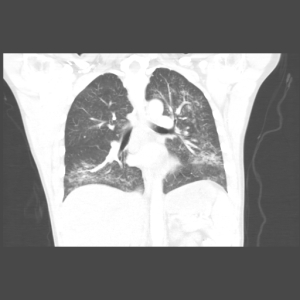by
John R. Fischer, Senior Reporter | November 14, 2019

A new algorithm could help in diagnosing
and treating EVALI early on
More than 2,000 cases of e-cigarette, or vaping, product use associated lung injury (EVALI) have been reported since the rise of the vaping epidemic last spring, according to the Centers for Disease Control and Prevention (CDC). With 40 people already dead, the medical community is urging the development of efficient tools to diagnose and treat the condition early.
Researchers at the University of Rochester are addressing this very issue with experts from New York State Department of Health through the development of a diagnostic/treatment algorithm that builds upon early guidance of the CDC for managing the condition.
“A clinician who may be unfamiliar with the diagnosis, if they have a patient who has a certain set of complaints, can pull out this tool and review the complaints that may be associated with EVALI,” Dr. Nicholas Nacca, a medical toxicologist and emergency medicine physician at the University of Rochester Medical Center, told HCB News. “It then guides them to ask more questions about vaping, which is something we didn’t really do before this epidemic. We didn’t really ask our patients regularly what they vape, how frequently they vape, and where they are purchasing the products they vape.”



Ad Statistics
Times Displayed: 172931
Times Visited: 3140 For those who need to move fast and expand clinical capabilities -- and would love new equipment -- the uCT 550 Advance offers a new fully configured 80-slice CT in up to 2 weeks with routine maintenance and parts and Software Upgrades for Life™ included.
The development of EVALI can lead to devastating lung damage injury, with some patients requiring long hospitalizations and treatment in intensive care units, followed by slow recoveries. Symptoms can include shortness of breath, fever, nausea and vomiting, abdominal pain, and weight loss.
The algorithm provides clinicians with a flow chart in which they can gather and assess patient information. Along with reviewing clinical symptoms typically associated with the disease, the solution provides relevant questions to ask patients, with clinicians then using their judgment to determine if EVALI could be a possible diagnosis. If it could be, the patient is sent to undergo an X-ray or CT scan, and laboratory testing. If the findings align with those of EVALI, the algorithm then provides broad recommendations for early treatment.
Another sign of EVALI that the algorithm considers is whether the patient has a history of vaping within the past 30 days, compared to the CDC which encourages evaluations for those who have vaped in the last 90 days. The solution can be used by all clinicians, including those in urgent care, office space settings, clinics, primary care offices, and emergency care departments.
The exact cause of the condition is still unknown, though some suspect THC may play a role, due to many patients having used vaping products that contain the substance, which is a psychoactive component in marijuana. Nacca says the use of the algorithm will help reduce missed diagnoses that are mistaken for colds or the flu, but cautions that spreading awareness about EVALI and the need to be tested must be done in a delicate fashion.
“We don’t want to make people afraid that they’re ill when maybe they’re not,” he said. “Medical professionals should be aware of the omen and the symptoms associated with the omen. They should discuss vaping activity with their patients, as well as all drug or chemical-dependency issues more openly. Patients developing symptoms, such as shortness of breath and fever, are the ones that are most appropriate to use the tool on, to diagnose and treat, as opposed to those who are vaping and have no symptoms. In those cases, you don’t need to go to the doctor. Just stop vaping.”
The findings were published in
The Lancet Respiratory Medicine.

